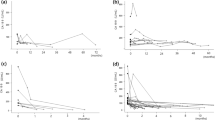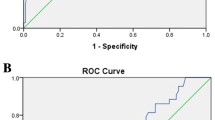Abstract
Background Carbohydrate antigen 19.9 (CA19.9), a tumor marker for malignancies of the hepatobiliary tract and pancreas, has frequently been shown to be deranged in a number of non-malignant conditions that are associated with jaundice. This study aims to demonstrate the correlation between CA19.9 and serum bilirubin concentration in patients with benign conditions and to determine the frequency of a false-positive increase in CA19.9 in patients being investigated for potential HPB malignancies. Methods This is a retrospective review of 83 consecutive patients presenting with an abnormal CA19.9 and radiological or clinical features suggestive of HPB malignancy subsequently shown to have benign disease. All patients were thoroughly investigated and followed up until the diagnosis of malignancy could be safely excluded. Results Serum bilirubin, sodium, lymphocyte count, neutrophil:lymphocyte ratio (NLR), β-human chorionic gonadotrophin (HCG), and age were found to correlate with CA19.9 by Pearson’s correlation (P = 0.001, P = 0.006, P = 0.006, P < 0.001, P = 0.012, and P = 0.049, respectively). In multivariate regression analysis, bilirubin was identified as an independent variable that may predict CA19.9 level (P = 0.028). Conclusion CA19.9 level is significantly influenced by serum bilirubin and elevated levels have been observed in patients with non-malignant HPB conditions. Adjusting CA19.9 according to bilirubin levels is likely to improve the specificity of this antigen in the differential diagnosis of benign and malignant HPB diseases and its reliability in the monitoring of disease response to chemotherapy.


Similar content being viewed by others
References
Laulu S, Roberts W (2007) Performance characteristics of five automated CA19.9 assays. Am J Clin Pathol 127:436–440
Nishihara S, Narimatsu H, Iwasaki H, Yazawa S, Akamatsu S, Ando T et al (1994) Molecular genetic analysis of the human Lewis histo-blood group system. J Biol Chem 269:29271–29278
Goonetilleke K, Siriwardena A (2007) Systematic review of carbohydrate antigen (CA19.9) as a biochemical marker in the diagnosis of pancreatic cancer. Eur J Surg Oncol 33:266–270. doi:10.1016/j.ejso.2006.10.004
Szekanecz E, Sandor Z, Antal-Szalmas P, Soos L, Lakos G, Besenyei T et al (2007) Increased production of the soluble tumor-associated antigens CA19.9, CA125 and CA15.3 in rheumatoid arthritis: potential adhesion molecules in synovial inflammation? Ann N Y Acad Sci 1108:359–371. doi:10.1196/annals.1422.037
Kodama T, Satoh H, Ishikawa H, Ohtsuka M (2007) Serum levels of CA19.9 in patients with nonmalignant respiratory diseases. J Clin Lab Anal 21:103–106. doi:10.1002/jcla.20136
Onishi R, Franco O, Shibahara T, Arima K, Sugimura Y (2005) Papillary adenocarcinoma of the renal pelvis and ureter producing carcinoembryonic antigen, carbohydrate antigen 19.9 and carbohydrate antigen 125. Int J Urol 12:214–216. doi:10.1111/j.1442–2042.2005.01009.x
Robertson A, Davidson B (2007) Mirizzi syndrome complicating an anomalous biliary tract: a novel cause of a hugely elevated CA19.9. Eur J Gastroenterol Hepatol 19:167–169. doi:10.1097/MEG.0b013e3280122879
Toomey DP, Swan N, Torreggiani W, Conlon KC (2007) Autoimmune pancreatitis: medical and surgical management. JOP 8:335–343
Murray M, Burton F, Bisceqlie A (2007) Markedly elevated serum CA19.9 levels in association with a benign biliary stricture due to primary sclerosing cholangitis. J Clin Gastroenterol 41:115–117. doi:10.1097/MCG.0b013e31802dd094
Uygur-Bayramicli O, Dabak R, Orbay E, Dolapcioglu C, Sargin M, Kilicoglu G et al (2007) Type 2 diabetes mellitus and CA19.9 levels. World J Gastroenterol 13:5357–5359
Madonia S, Aragona E, Maisano S, Montalbano L, Olivo M, Rossi F et al (2007) CA19.9 to rule out pancreatic or biliary cancer among patients with cholestasis: an unsuitable test? Dig Dis Sci 52:1125–1127. doi:10.1007/s10620-006-9532-3
Mann D, Edwards R, Ho S, Lau W, Glazer G (2000) Elevated tumour marker CA19.9: clinical interpretation and influence of obstructive jaundice. Eur J Surg Oncol 26:474–479. doi:10.1053/ejso.1999.0925
Duraker N, Hot S, Polat Y, Hobek A, Gencler N, Urhan N (2007) CEA, CA19.9, CA125 in the differential diagnosis of benign and malignant pancreatic diseases with or without jaundice. J Surg Oncol 95:142–147. doi:10.1002/jso.20604
Kim H, Kim M, Myung S, Lim B, Park E, Yoo K et al (1999) A new strategy for the application of CA19.9 in the differentiation of pancreaticobiliary cancer: analysis using a receiver operating characteristic curve. Am J Gastroenterol 94:1941–1946. doi:10.1111/j.1572-0241.1999.01234.x
Kang C, Kim J, Choi G, Kim K, Choi J, Lee W et al (2006) The use of adjusted preoperative CA19.9 to predict the recurrence of resectable pancreatic cancer. J Surg Res 140:31–35. doi:10.1016/j.jss.2006.10.007
Ulla Rocha JL, Alvarez Sanchez MV, Paz Esquete J et al (2007) Evaluation of the bilio-pancreatic region using endoscopic ultrasonography in patients referred with and without abdominal pain and CA19.9 serum level elevation. JOP 8:191–197
Fernandez-Esparrach G, Gines A, Garcia P, Pellise M, Sole M, Cortes P et al (2007) Incidence and clinical significance of hyperamylasemia after endoscopic ultrasound-guided fine-needle aspiration (EUS-FNA) of pancreatic lesions: a prospective and controlled study. Endoscopy 39:720–724. doi:10.1055/s-2007-966719
Iglesias-Garcia J, Dominguez-Munoz E, Lozano-Leon A, Abdulkader I, Larino-Noia J, Antunez J et al (2007) Impact of endoscopic ultrasound-guided fine needle biopsy for diagnosis of pancreatic masses. World J Gastroenterol 13:289–293
Halm U, Schumann T, Schiefke I, Witzigmann H, Mossner J, Keim V (2000) Decrease of CA19.9 during chemotherapy with gemcitabine predicts survival time in patients with advanced pancreatic cancer. Br J Cancer 82:1013–1016. doi:10.1054/bjoc.1999.1035
Ko A, Hwang J, Venook A, Abbruzzese J, Bergsland E, Tempero M (2005) Serum CA19.9 response as a surrogate for clinical outcome in patients receiving fixed-dose rate gemcitabine for advanced pancreatic cancer. Br J Cancer 93:195–199. doi:10.1038/sj.bjc.6602687
Benamouzig R, Buffett C, Fourre C, Ink O, Moati F, Etienne J (1989) Serum levels of carbohydrate antigen determinant (CA19.9) in obstructive jaundice. Dig Dis Sci 34:1640–1642. doi:10.1007/BF01537129
Basso D, Meggiato T, Fabris C et al (1992) Extrahepatic cholestasis determines a reversible increase of glycoprotein tumor markers in benign and malignant disease. Eur J Clin Invest 22:800–804. doi:10.1111/j.1365-2362.1992.tb01449.x
Acknowledgments
We would like to thank Sara Whatton (Multi Disciplinary Team Co-ordinator and Data Analyst), Elizabeth Mackness (Clinical Audit Standards and Effectiveness team assistant), and Medical Records Department for their support throughout this study.
Author information
Authors and Affiliations
Corresponding author
Rights and permissions
About this article
Cite this article
Ong, S.L., Sachdeva, A., Garcea, G. et al. Elevation of Carbohydrate Antigen 19.9 in Benign Hepatobiliary Conditions and Its Correlation with Serum Bilirubin Concentration. Dig Dis Sci 53, 3213–3217 (2008). https://doi.org/10.1007/s10620-008-0289-8
Received:
Accepted:
Published:
Issue Date:
DOI: https://doi.org/10.1007/s10620-008-0289-8




